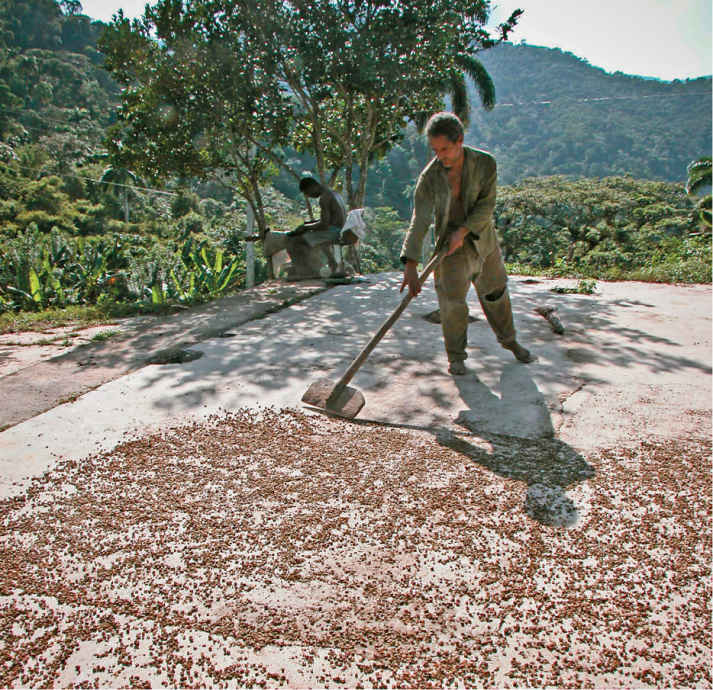Coffee came to Cuba from the island of Hispaniola in 1748, but there was little coffee industry to speak of until the influx of French settlers in 1791, fleeing the Haitian revolution. By 1827 there were around two thousand coffee farms on the island and coffee became a major export, generating more money than sugar.

Castro’s revolution, from 1953 to 1961, brought with it the nationalization of coffee farms and production dropped almost immediately. Those who volunteered to farm coffee had no experience and those who had previously worked the land had fled the country in the wake of the revolution. Coffee production struggled on the island, and little in the way of incentives or encouragement from the government did much to bolster the industry, though production did peak in the 1970s at around 30,000 tonnes (30,000 tons) of coffee. As Cuba’s coffee industry was faltering, many Central American countries continued to enjoy greater exports and success in international markets.
The breakdown of the Soviet Union left Cuba increasingly isolated, and the trade embargo placed on Cuba by the United States removed a major potential market. Japan has been the major importer of Cuban coffee, though Europe remains a strong market. The best coffees are typically exported, usually around one-fifth of the total production, leaving the rest for domestic consumption. Cuba’s own production does not cover domestic demand and in 2013 the country spent nearly $40 million on imported coffee. The coffee being imported into Cuba is not of the highest quality so it is relatively cheap, but high market prices have led to the reappearance of the habit of mixing in roasted peas to bulk out the coffee.
‘CUBAN COFFEE’
A number of Cuban coffee preparations have spread around the world, including Cortadito, Café con Leche and Café Cubano. The latter refers to an espresso that is sweetened as it is brewed, by adding sugar to the ground coffee.
In the United States especially, and in other places, it is not uncommon to see ‘Cuban Coffee’ advertised. True Cuban coffee is illegal in the United States due to the trade embargo, but this term is often used to describe a Café Cubano. Coffees, often from Brazil, are selected to represent the flavours one might expect from Cuba but there are, of course, concerns about confusion among customers and mislabelling of goods.
Right now Cuban coffee production remains low at around 6,000–7,000 tonnes (6,600–7,700 tons) a year. Much of the equipment used is old, and many producers are still reliant on mules. Roads are often badly damaged by alternating rain and drought and are poorly maintained. Coffee is usually dried in the sun, though some mechanical drying takes place, and most of the coffees grown for export are washed. Cuba’s climate and topography are well suited to coffee growing and its scarcity may add much to its value, but there are many challenges facing those producers wishing to create high-quality coffees.
TRACEABILITY
Cuban coffees are unlikely to be traceable down to a single farm, and are often only traceable down to a particular region or sub-region of the country.
 Though the climate and topography suit the crop, Cuba’s coffee industry suffers from poor infrastructure and equipment.
Though the climate and topography suit the crop, Cuba’s coffee industry suffers from poor infrastructure and equipment.
TASTE PROFILE
Cuban coffees have a typical island coffee profile: relatively low in acidity with a heavier body.
GROWING REGIONS
Population: 11,239,000
Number of 60kg (132lb) bags in 2016: 100,000
Cuba is the largest island in the Caribbean. Much of it is relatively low-lying plains but there are some mountainous areas suitable for coffee.
SIERRA MAESTRA
This mountainous region runs the length of the southern coast and has a long history of guerrilla warfare, from the 1500s to the revolution in the 1950s. Most of the coffee production on the island is located here.
| Altitude: | 1,000–1,200m (3,300–3,900ft) |
| Harvest: | July–December |
| Varieties: | Mostly Typica, some Bourbon, Caturra, Catuai, Catimor |
SIERRA DEL ESCAMBRAY
A small amount of Cuba’s coffee is grown in this mountain range in the middle of the island.
| Altitude: | 350–900m (1,100–3,000ft) |
| Harvest: | July–December |
| Varieties: | Mostly Typica, some Bourbon, Caturra, Catuai, Catimor |
SIERRA DEL ROSARIO
Coffee farms have existed in this region since 1790, though relatively little of Cuba’s coffee is grown here now. Instead the mountains are home to Cuba’s first Biosphere Reserve, and this is a protected area.
| Altitude: | 300–550m (1,000–1,800ft) |
| Harvest: | July–December |
| Varieties: | Mostly Typica, some Bourbon, Caturra, Catuai, Catimor |